A Multi-Criteria Approach to Evaluate Sustainability: A Case Study of the Navarrese Wine Sector
Abstract
:1. Introduction
2. Materials and Methods
2.1. Environmental Dimension
2.2. AHP Method
- Individual producers: 4 owners of Navarrese wineries;
- Vine and wine producer aggrupations or representatives: UAGN (1 R&D manager, 1 technician), Federación Española del Vino—Wine Spanish Federation (FEV) (1 technician), CR D.O.P. Navarra (CEO and President);
- Wine research demonstration and Innovation and knowledge transfer organizations: the Instituto Tecnológico del Vino—Wine Technological Institute (VITEC) (managing director) and la Plataforma Tecnológica del Vino—Wine Technological Platform in Spain (PTV) (President);
- International Federation of Wines and Spirits (FIVS) (Vice President).
2.3. KPI Assessment Outcome
3. Results and Discussion
4. Conclusions
Author Contributions
Funding
Data Availability Statement
Conflicts of Interest
References
- European Commission; Eurostat; E. Cook. Key Figures on the European Food Chain, 2021 ed.; Publications Office of the European Union. Available online: https://ec.europa.eu/eurostat/web/products-key-figures/-/ks-fk-21-001 (accessed on 11 January 2022).
- EU. Eurostat. Wine Production and Trade in the EU—Products Eurostat News—Eurostat. Available online: https://ec.europa.eu/eurostat/web/products-eurostat-news/-/EDN-20201119-2 (accessed on 11 January 2022).
- Annunziata, E.; Pucci, T.; Frey, M.; Zanni, L. The role of organizational capabilities in attaining corporate sustainability practices and economic performance: Evidence from Italian wine industry. J. Clean. Prod. 2018, 171, 1300–1311. [Google Scholar] [CrossRef]
- Flores, S.S. What is sustainability in the wine world? A cross-country analysis of wine sustainability frameworks. J. Clean. Prod. 2018, 172, 2301–2312. [Google Scholar] [CrossRef]
- Forbes, S.L.; Cohen, D.A.; Cullen, R.; Wratten, S.D.; Fountain, J. Consumer attitudes regarding environmentally sustainable wine: An exploratory study of the New Zealand marketplace. J. Clean. Prod. 2009, 17, 1195–1199. [Google Scholar] [CrossRef]
- Fourment, M.; Ferrer, M.; Barbeau, G.; Quénol, H. Local Perceptions, Vulnerability and Adaptive Responses to Climate Change and Variability in a Winegrowing Region in Uruguay. Environ. Manag. 2020, 66, 590–599. [Google Scholar] [CrossRef] [PubMed]
- Sacchelli, S.; Fabbrizzi, S.; Bertocci, M.; Marone, E.; Menghini, S.; Bernetti, I. A mix-method model for adaptation to climate change in the agricultural sector: A case study for Italian wine farms. J. Clean. Prod. 2017, 166, 891–900. [Google Scholar] [CrossRef]
- Schäufele, I.; Hamm, U. Consumers’ perceptions, preferences and willingness-to-pay for wine with sustainability characteristics: A review. J. Clean. Prod. 2017, 147, 379–394. [Google Scholar] [CrossRef]
- Christ, K.L.; Burritt, R.L. Critical environmental concerns in wine production: An integrative review. J. Clean. Prod. 2013, 53, 232–242. [Google Scholar] [CrossRef]
- European Commission. From Farm to Fork. Available online: https://ec.europa.eu/food/horizontal-topics/farm-fork-strategy_en (accessed on 25 January 2022).
- European Commission, CAP Reform National Strategic Plan 2023–2027. Available online: https://www.mapa.gob.es/es/pac/post-2020/default.aspx (accessed on 25 January 2022).
- Morkunas, M.; Volkov, A. The Progress of the Development of a Climate-smart Agriculture in Europe: Is there Cohesion in the European Union? Environ. Manag. 2023, 71, 1111–1127. [Google Scholar] [CrossRef]
- Martínez-Casasnovas, J.A.; Ramos, M.C.; Cots-Folch, R. Influence of the EU CAP on terrain morphology and vineyard cultivation in the Priorat region of NE Spain. Land Use Policy 2010, 27, 11–21. [Google Scholar] [CrossRef]
- Cabezas, H.; Pawlowski, C.W.; Mayer, A.L.; Hoagland, N.T. Sustainability: Ecological, social, economic, technological, and systems perspectives. Clean Technol. Environ. Policy 2003, 5, 167–180. [Google Scholar] [CrossRef]
- Ferrer, J.R.; García-Cortijo, M.C.; Pinilla, V.; Castillo-Valero, J.S. The business model and sustainability in the Spanish wine sector. J. Clean. Prod. 2021, 330, 129810. [Google Scholar] [CrossRef]
- Carroquino, J.; Garcia-Casarejos, N.; Gargallo, P. Classification of Spanish wineries according to their adoption of measures against climate change. J. Clean. Prod. 2019, 244, 118874. [Google Scholar] [CrossRef]
- Schimmenti, E.; Migliore, G.; Di Franco, C.P.; Borsellino, V. Is there sustainable entrepreneurship in the wine industry? Exploring Sicilian wineries participating in the SOStain program. Wine Econ. Policy 2016, 5, 14–23. [Google Scholar] [CrossRef]
- Baiano, A. An Overview on Sustainability in the Wine Production Chain. Beverages 2021, 7, 15. [Google Scholar] [CrossRef]
- Lorenzo, J.R.F.; Rubio, M.T.M.; Garcés, S.A. The competitive advantage in business, capabilities and strategy. What general performance factors are found in the Spanish wine industry? Wine Econ. Policy 2018, 7, 94–108. [Google Scholar] [CrossRef]
- Chhipi-Shrestha, G.K.; Hewage, K.; Sadiq, R. ‘Socializing’ sustainability: A critical review on current development status of social life cycle impact assessment method. Clean Technol. Environ. Policy 2014, 17, 579–596. [Google Scholar] [CrossRef]
- Van Schoubroeck, S.; Van Dael, M.; Van Passel, S.; Malina, R. A review of sustainability indicators for biobased chemicals. Renew. Sustain. Energy Rev. 2018, 94, 115–126. [Google Scholar] [CrossRef]
- Semin, A.; Betin, O.; Namyatova, L.; Kireeva, E.; Vatutina, L.; Vorontcov, A.; Bagaeva, N. Sustainable Condition of the Agricultural Sector’s Environmental, Economic, and Social Components from the Perspective of Open Innovation. J. Open Innov. Technol. Mark. Complex. 2021, 7, 74. [Google Scholar] [CrossRef]
- Gilinsky, A., Jr.; Newton, S.K.; Vega, R.F. Sustainability in the Global Wine Industry: Concepts and Cases. Agric. Agric. Sci. Procedia 2016, 8, 37–49. [Google Scholar] [CrossRef]
- Jeziorska-Biel, P.; Leśniewska-Napierała, K.; Czapiewski, K. (Circular) Path Dependence—The Role of Vineyards in Land Use, Society and Regional Development—The Case of Lubuskie Region (Poland). Energies 2021, 14, 8425. [Google Scholar] [CrossRef]
- Azti. Eatendencias: Las Tendencias Con Mayor Impacto Para la Innovación Alimentaria—Azti. Available online: https://www.azti.es/eatendencias-las-tendencias-con-mayor-impacto-para-la-innovacion-alimentaria/ (accessed on 25 January 2022).
- Islam, S.; Ponnambalam, S.G.; Lam, H.L. A novel framework for analyzing the green value of food supply chain based on life cycle assessment. Clean Technol. Environ. Policy 2016, 19, 93–103. [Google Scholar] [CrossRef]
- Ardente, F.; Beccali, G.; Cellura, M.; Marvuglia, A. POEMS: A Case Study of an Italian Wine-Producing Firm. Environ. Manag. 2006, 38, 350–364. [Google Scholar] [CrossRef] [PubMed]
- Merli, R.; Preziosi, M.; Acampora, A. Sustainability experiences in the wine sector: Toward the development of an international indicators system. J. Clean. Prod. 2018, 172, 3791–3805. [Google Scholar] [CrossRef]
- Italian Ministry for the Environment, Land and Sea. Wine Observatory Sustainability—V.I.V.A. Sustainability and Culture. Available online: http://wineobservatorysustainability.eu/en/sharing/VIVA-Sustainability-and-Culture.9/ (accessed on 25 January 2022).
- Arnal, Á.J.; Díaz-Ramírez, M.; Acevedo, L.; Ferreira, V.J.; García-Armingol, T.; López-Sabirón, A.M.; Ferreira, G. Multicriteria analysis for retrofitting of natural gas melting and heating furnaces for sustainable manufacturing and industry 4.0. J. Energy Resour. Technol. 2020, 142, 022203. [Google Scholar] [CrossRef]
- D’Ammaro, D.; Capri, E.; Valentino, F.; Grillo, S.; Fiorini, E.; Lamastra, L. A multi-criteria approach to evaluate the sustainability performances of wines: The Italian red wine case study. Sci. Total. Environ. 2021, 799, 149446. [Google Scholar] [CrossRef] [PubMed]
- Blecua-De-Pedro, M.; Díaz-Ramírez, M.C. Assessment of Potential Barriers to the Implementation of an Innovative AB-FB Energy Storage System under a Sustainable Perspective. Sustainability 2021, 13, 11042. [Google Scholar] [CrossRef]
- Kumar, A.; Pant, S. Analytical hierarchy process for sustainable agriculture: An overview. MethodsX 2023, 10, 101954. [Google Scholar] [CrossRef]
- Nocera, F.; Caponetto, R.; Giuffrida, G.; Detommaso, M. Energetic Retrofit Strategies for Traditional Sicilian Wine Cellars: A Case Study. Energies 2020, 13, 3237. [Google Scholar] [CrossRef]
- Szolnoki, G. A cross-national comparison of sustainability in the wine industry. J. Clean. Prod. 2013, 53, 243–251. [Google Scholar] [CrossRef]
- Mohammed, A.; Setchi, R.; Filip, M.; Harris, I.; Li, X. An integrated methodology for a sustainable two-stage supplier selection and order allocation problem. J. Clean. Prod. 2018, 192, 99–114. [Google Scholar] [CrossRef]
- González-García, S.; Rama, M.; Cortés, A.; García-Guaita, F.; Núñez, A.; Louro, L.G.; Moreira, M.T.; Feijoo, G. Embedding environmental, economic and social indicators in the evaluation of the sustainability of the municipalities of Galicia (northwest of Spain). J. Clean. Prod. 2019, 234, 27–42. [Google Scholar] [CrossRef]
- Gobierno de Navarra, UAGN. La Nueva Metodología Agroinnovarse Impulsará la Sostenibilidad en El Sector Agroalimentario. Available online: https://www.navarra.es/es/-/la-nueva-metodología-agroinnovarse-impulsará-la-sostenibilidad-en-el-sector-agroalimentario (accessed on 25 January 2022).
- ECO-Prowine Project. Home—ECO-Prowine. Available online: https://ecoprowine.org/ (accessed on 25 January 2022).
- Carrillo, V.; D’Souza, F.; Liedke, A.; Núnez, Y.; Pereda, L.; Clemente, R.; López, M.; Díez, J.A.; Gómez, S.; Cano, M.; et al. Combining type I and type iii eco-labels: A successful experience in the wine sector. In Perspectives of Managing Life Cycles—Proceedings from the 6th International Conference on Life Cycle Management—LCM 2013, Gothenburg, Sweden, 25–28 August 2023; LIFE 3.0—LIFE Project Public Page (europa.eu). 2013. Available online: https://www.academia.edu/download/72951218/Combining_Type_I_and_Type_III_Eco-labels20211017-23314-ynnjmz.pdf (accessed on 25 January 2022).
- European Commission. Product Environmental Footprint Category Rules (PEFCR) for Still and Sparkling Wine.-EUR-Lex-32021H2279-EN-EUR-Lex. (n.d.). Available online: https://eur-lex.europa.eu/legal-content/EN/TXT/?uri=CELEX%3A32021H2279 (accessed on 24 May 2023).
- Vinodh, S.; Jayakrishna, K.; Kumar, V.; Dutta, R. Development of decision support system for sustainability evaluation: A case study. Clean Technol. Environ. Policy 2013, 16, 163–174. [Google Scholar] [CrossRef]
- Knierim, A.; Boenning, K.; Caggiano, M.; Cristóvão, A.; Dirimanova, V.; Koehnen, T.; Labarthe, P.; Prager, K. The AKIS Concept and its Relevance in Selected EU Member States. Outlook Agric. 2015, 44, 29–36. [Google Scholar] [CrossRef]
- Ministerio de Agricultura, Pesca y Alimentación. Sistemas de Conocimiento E Innovación Agrícolas (AKIS). Available online: https://www.mapa.gob.es/es/desarrollo-rural/temas/innovacion-medio-rural/akis/ (accessed on 25 January 2022).
- De Castro, P.; Miglietta, P.P.; Vecchio, Y. The Common Agricultural Policy 2021–2027: A new history for European agriculture. Ital. Rev. Agric. Econ. 2020, 75, 1–37. [Google Scholar]
- ISO/TC 207/SC 1; Environmental Management Systems, ISO 14001:2015 Environmental Management Systems—Requirements with Guidance for Use, 3rd ed. ISO: Geneva Switzerland, 2015. Available online: http://www.iso.org/standard/60857.html (accessed on 25 January 2022).
- ISO/TC 207/SC 7; ISO 14064-1:2018-Greenhouse Gases—Part 1: Specification with Guidance at the Organization Level for Quantification and Reporting of Greenhouse Gas Emissions and Removals, 2nd ed. ISO: Geneva Switzerland, 2018. Available online: https://www.iso.org/standard/66453.html (accessed on 25 January 2022).
- ISO/TC 207/SC 3; Environmental Labelling, ISO 14025 Environmental Labels and Declarations—Type III Environmental Declarations—Principles and Procedures, 1st ed. ISO: Geneva Switzerland, 2006. Available online: https://www.iso.org/standard/38131.html (accessed on 25 January 2022).
- Gómez-Lorente, D.; Rabaza, O.; Aznar-Dols, F.; Mercado-Vargas, M.J. Economic and Environmental Study of Wineries Powered by Grid-Connected Photovoltaic Systems in Spain. Energies 2017, 10, 222. [Google Scholar] [CrossRef]
- Ferdeș, M.; Zăbavă, B.; Paraschiv, G.; Ionescu, M.; Dincă, M.N.; Moiceanu, G. Food Waste Management for Biogas Production in the Context of Sustainable Development. Energies 2022, 15, 6268. [Google Scholar] [CrossRef]
- ISO/TC 207/SC 5; Life Cycle Assessment, ISO 14040—Environmental Management—Life Cycle Assessment—Principles and Framework, 2nd ed. ISO: Geneva Switzerland, 2006. Available online: https://www.iso.org/standard/37456.html (accessed on 1 July 2006).
- Pattara, C.; Raggi, A.; Cichelli, A. Life Cycle Assessment and Carbon Footprint in the Wine Supply-Chain. Environ. Manag. 2012, 49, 1247–1258. [Google Scholar] [CrossRef] [PubMed]
- Sharma, R.K.; Sarkar, P.; Singh, H. Assessing the sustainability of a manufacturing process using life cycle assessment technique—A case of an Indian pharmaceutical company. Clean Technol. Environ. Policy 2020, 22, 1269–1284. [Google Scholar] [CrossRef]
- Sharma, R.K.; Singh, P.K.; Sarkar, P.; Singh, H. A hybrid multi-criteria decision approach to analyze key factors affecting sustainability in supply chain networks of manufacturing organizations. Clean Technol. Environ. Policy 2020, 22, 1871–1889. [Google Scholar] [CrossRef]
- Escobar, M.; Aguarón, J.; Moreno-Jiménez, J. A note on AHP group consistency for the row geometric mean priorization procedure. Eur. J. Oper. Res. 2004, 153, 318–322. [Google Scholar] [CrossRef]
- Saaty, R.W. The analytic hierarchy process—What it is and how it is used. Math. Model. 1987, 9, 161–176. [Google Scholar] [CrossRef]
- Russo, R.D.F.S.M.; Camanho, R. Criteria in AHP A Systematic Review of Literature. Procedia Comput. Sci. 2015, 55, 1123–1132. [Google Scholar] [CrossRef]
- Martucci, O.; Arcese, G.; Montauti, C.; Acampora, A. Social Aspects in the Wine Sector: Comparison between Social Life Cycle Assessment and VIVA Sustainable Wine Project Indicators. Resources 2019, 8, 69. [Google Scholar] [CrossRef]
- Brunner, B.; Igic, I.; Keller, A.C.; Wieser, S. Who gains the most from improving working conditions? Health-related absenteeism and presenteeism due to stress at work. Eur. J. Health Econ. 2019, 20, 1165–1180. [Google Scholar] [CrossRef] [PubMed]
- Martins, A.; Costa, M.; Araújo, A.; Morgado, A.; Pereira, J.; Fontes, N.; Graça, A.; Caetano, N.; Mata, T. Sustainability evaluation of a Portuguese “terroir” wine. BIO Web Conf. 2019, 12, 03017. [Google Scholar] [CrossRef]
- Luz, G.P.; Amaro e Silva, R. Modeling Energy Communities with Collective Photovoltaic Self-Consumption: Synergies between a Small City and a Winery in Portugal. Energies 2021, 14, 323. [Google Scholar] [CrossRef]
- Tena, M.; Perez, M.; Solera, R. Benefits in the valorization of sewage sludge and wine vinasse via a two-stage acidogenic-thermophilic and methanogenic-mesophilic system based on the circular economy concept. Fuel 2021, 296, 120654. [Google Scholar] [CrossRef]
- Ncube, A.; Fiorentino, G.; Colella, M.; Ulgiati, S. Upgrading wineries to biorefineries within a Circular Economy perspective: An Italian case study. Sci. Total. Environ. 2021, 775, 145809. [Google Scholar] [CrossRef]
- Landi, D.; Germani, M.; Marconi, M. Analyzing the environmental sustainability of glass bottles reuse in an Italian wine consortium. Procedia CIRP 2019, 80, 399–404. [Google Scholar] [CrossRef]
- Vázquez, J.J.; Cebolla, M.P.C.; Ramos, F.S. Digital transformation in the Spanish agri-food cooperative sector: Situation and prospects. CIRIEC-Esp. Rev. De Econ. Publica Soc. Y Coop. 2019, 95, 39–70. [Google Scholar] [CrossRef]
- Pivetta, D.; Rech, S.; Lazzaretto, A. Choice of the Optimal Design and Operation of Multi-Energy Conversion Systems in a Prosecco Wine Cellar. Energies 2020, 13, 6252. [Google Scholar] [CrossRef]
- Dumitriu, G.D.; Teodosiu, C.; Cotea, V.V. Management of Pesticides from Vineyard to Wines: Focus on Wine Safety and Pesticides Removal by Emerging Technologies. Grapes Wine 2021, 7, 1–27. [Google Scholar] [CrossRef]
- BOE. BOE-A-2013-8554 Ley 12/2013, de 2 de Agosto, de Medidas Para Mejorar El Funcionamiento de la Cadena Alimentaria. Available online: https://www.boe.es/buscar/act.php?id=BOE-A-2013-8554&b=21&tn=1&p=20211215#a1-3 (accessed on 25 January 2022).
- BOE. BOE-A-2021-20630 Ley 16/2021, de 14 de Diciembre, Por la Que SE Modifica la Ley 12/2013, de 2 de Agosto, de Medidas Para Mejorar El Funcionamiento de la Cadena Alimentaria. Available online: https://www.boe.es/diario_boe/txt.php?id=BOE-A-2021-20630 (accessed on 25 January 2022).
- Huang, Y. Technology innovation and sustainability: Challenges and research needs. Clean Technol. Environ. Policy 2021, 23, 1663–1664. [Google Scholar] [CrossRef]
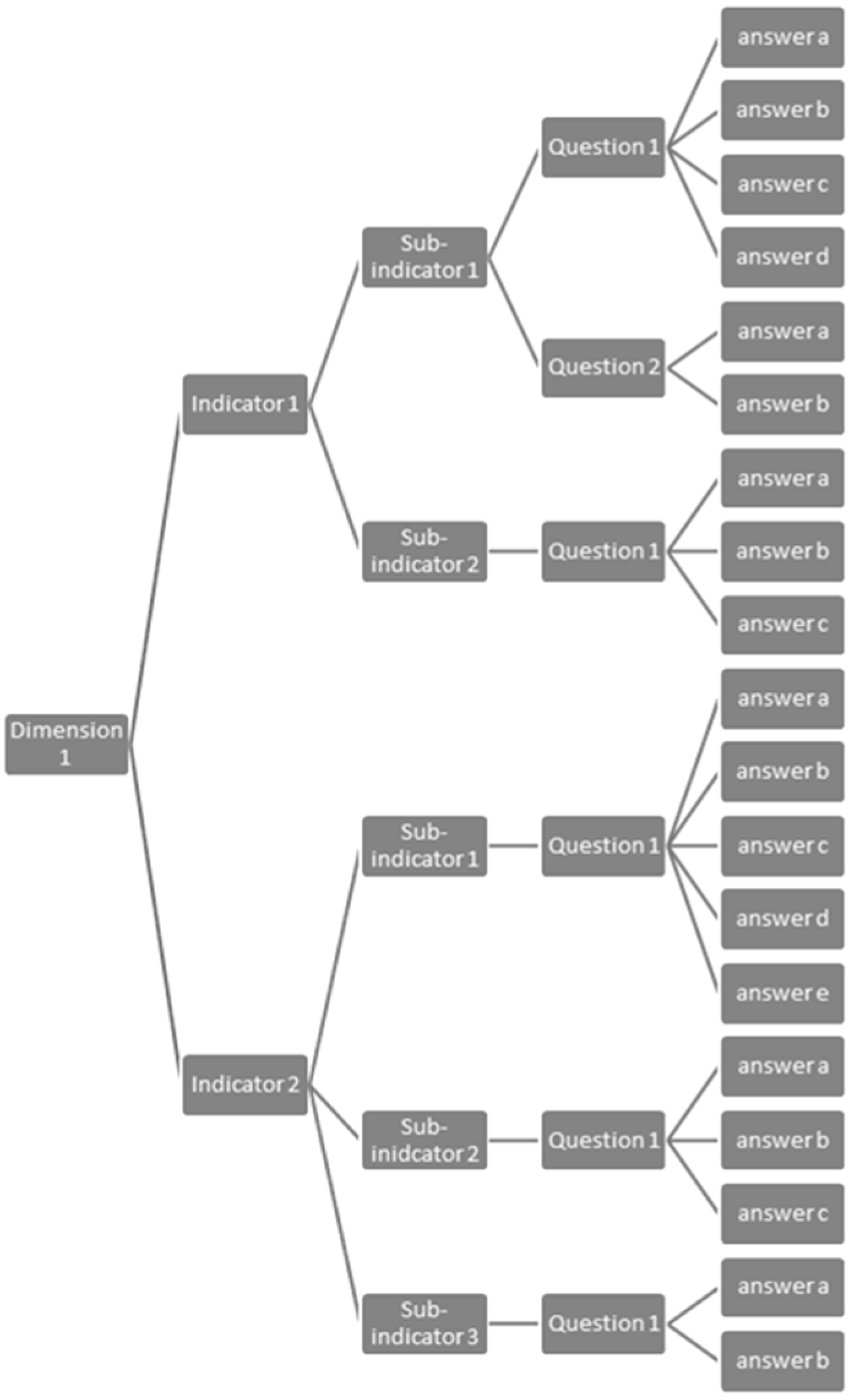
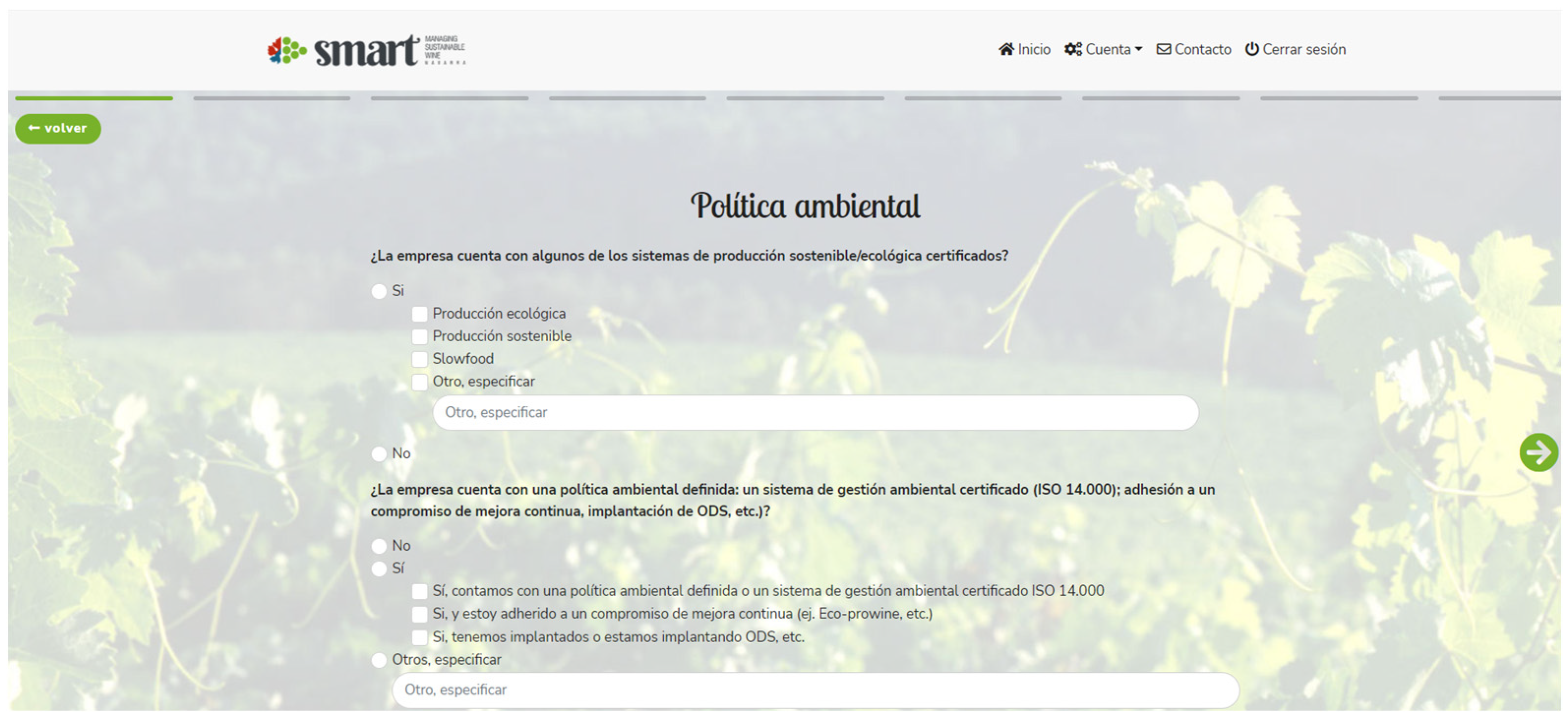
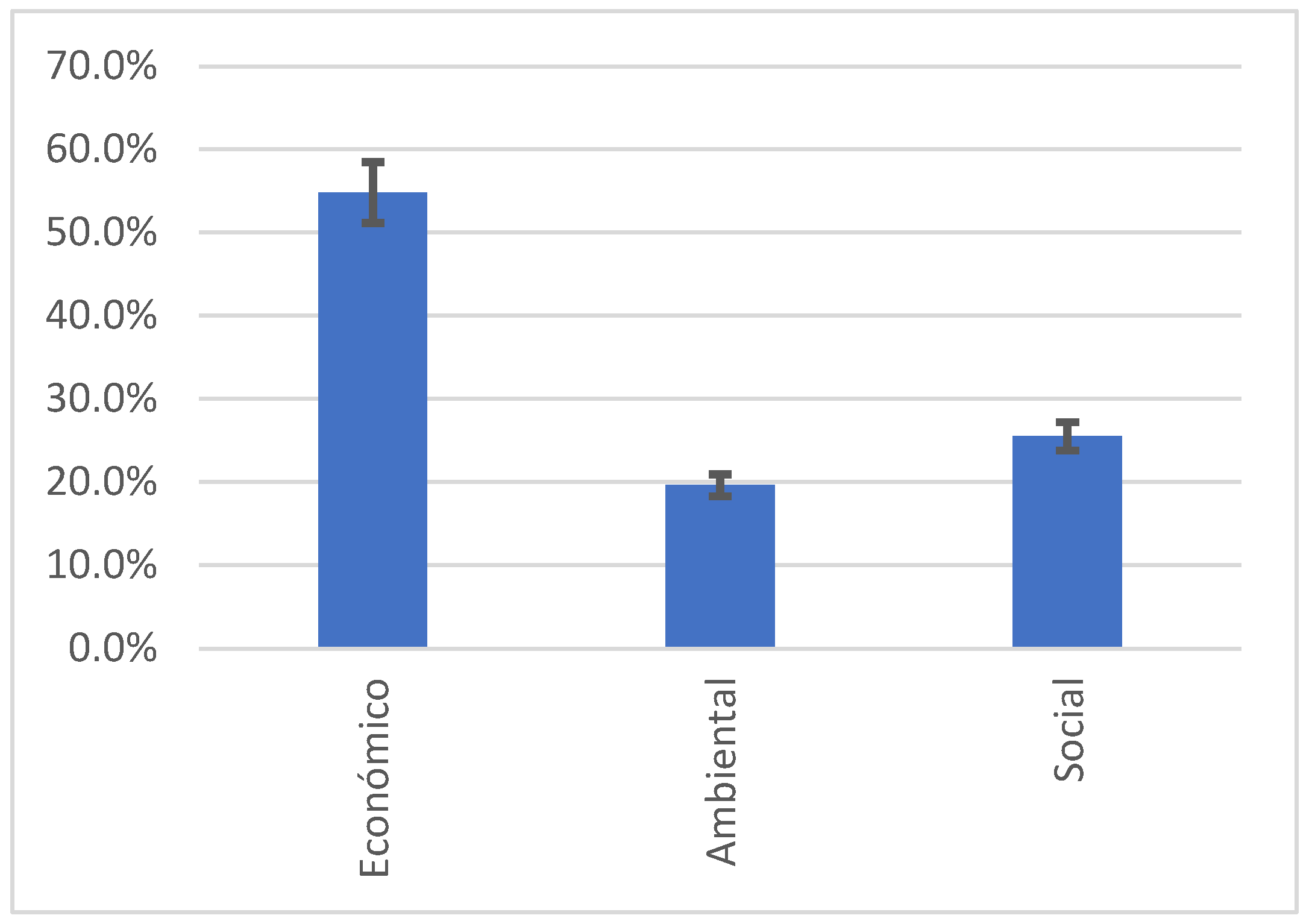

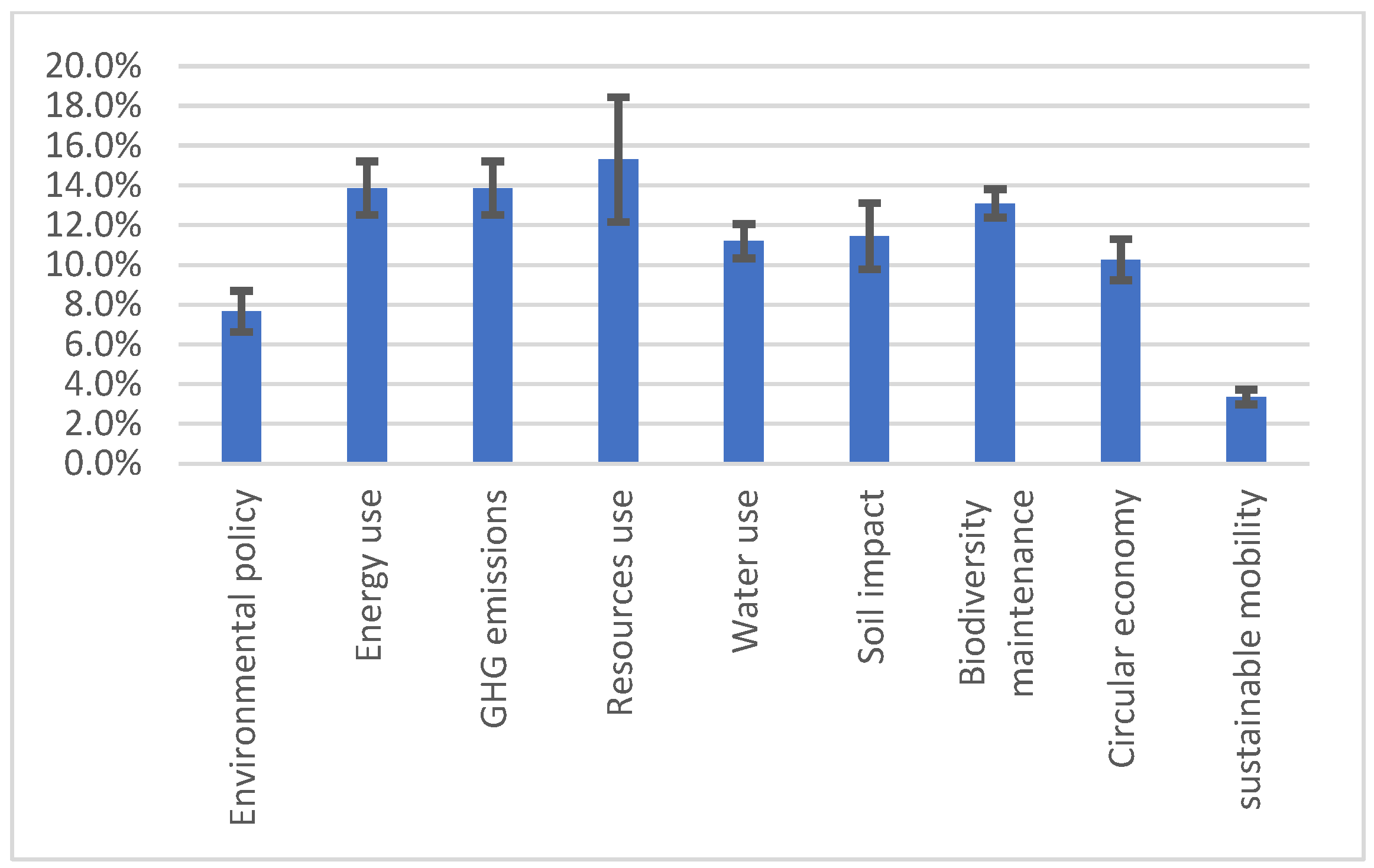
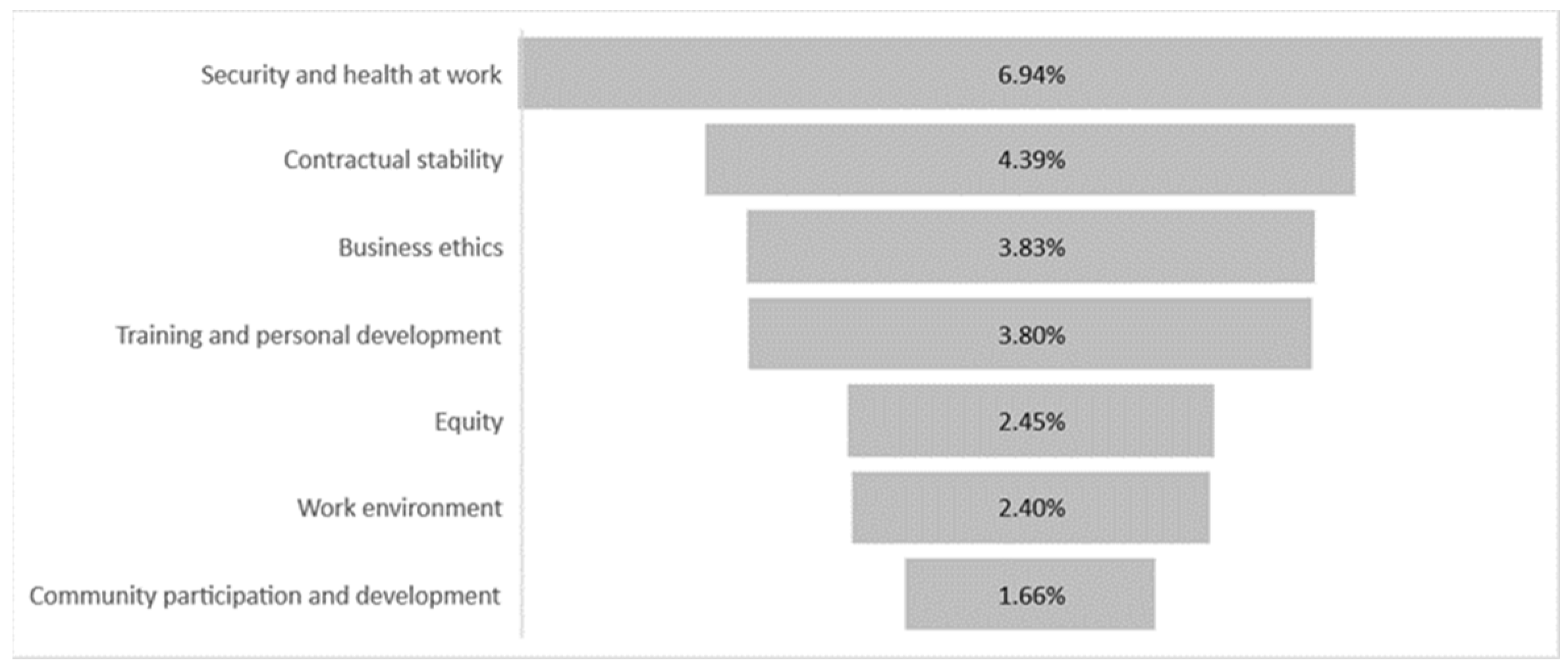
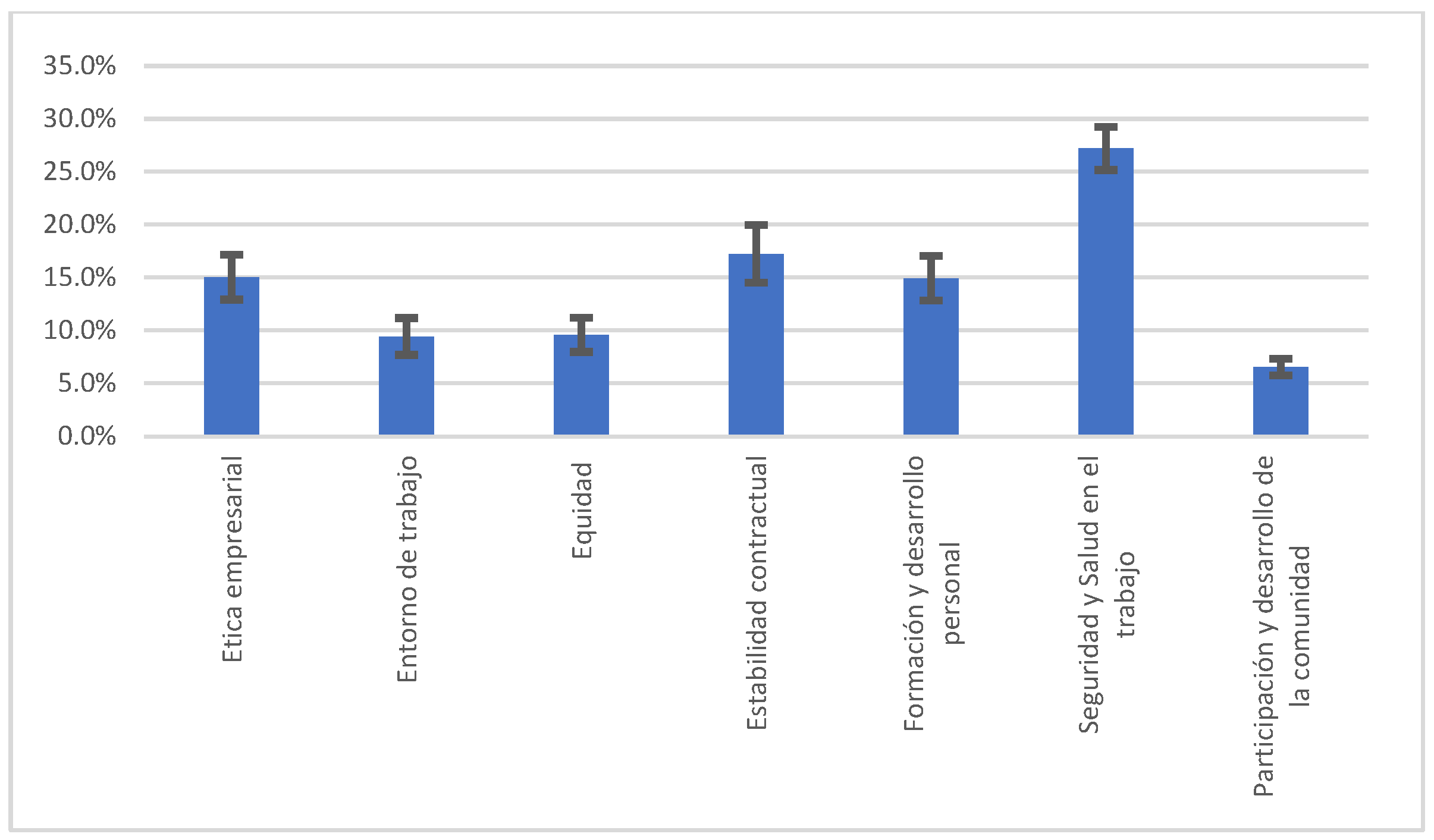

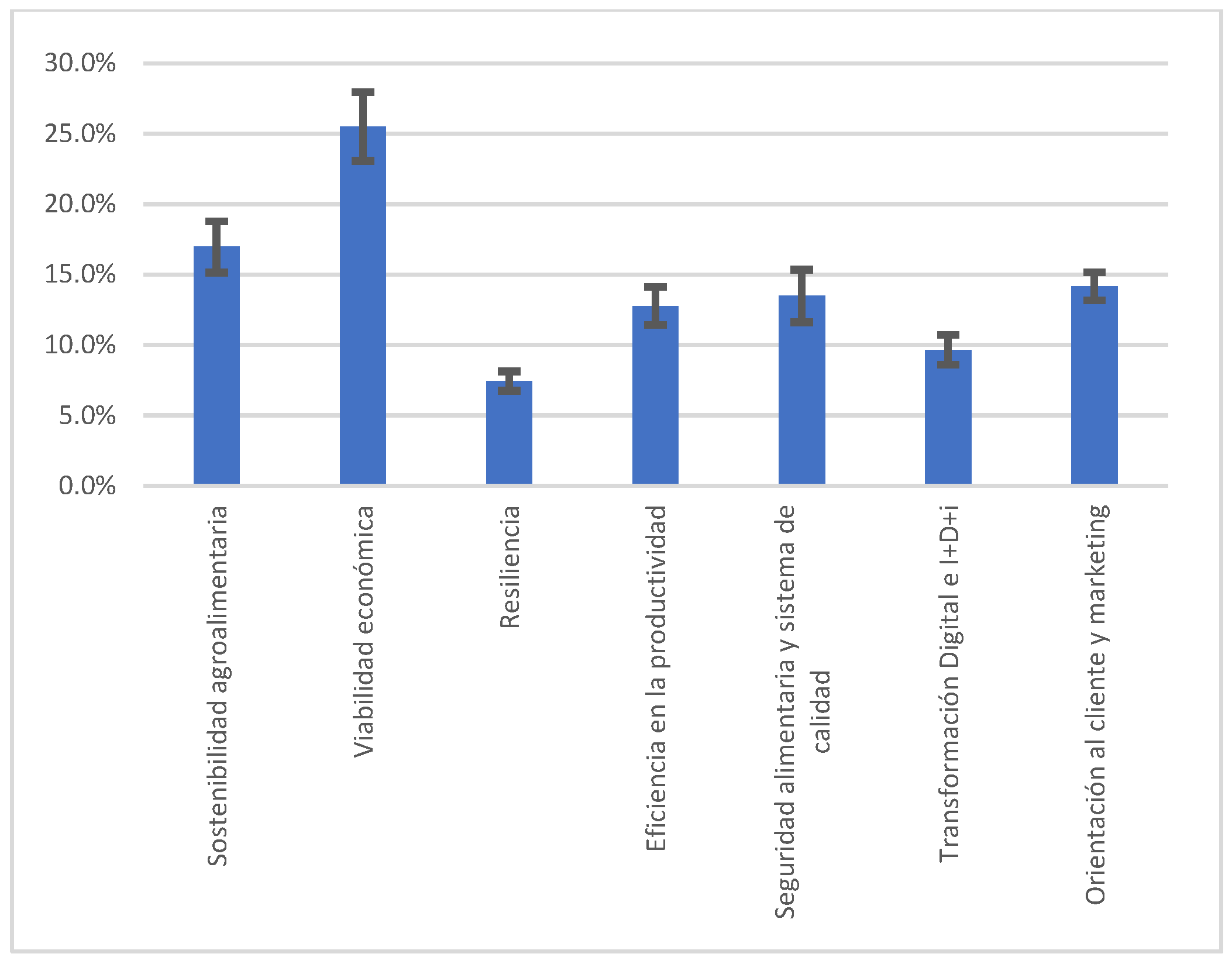
| Economic Dimension | Indicator | Sub-Indicators |
|---|---|---|
| Agri-food sustainability | Codes of good business practices, sustainable procurement protocol, food chain law | |
| Economic feasibility | User-driven business model, company investment plan, vineyard exploitation professionalism, CAP aid | |
| Resilience | Agricultural insurance system, financial advisory services procurement, climate change adaptation plan, contingency plan | |
| Productivity and efficiency | Productivity and efficiency monitoring, growth objectives and monitoring, improvement measures | |
| Food security and quality systems | Quality system, certification, food security, education for responsible consumption, communication on nutritional quality | |
| Digital transformation and R&D | Level of digitalization, reinforcement of R&D, digitalization-driven improvement, technology 4.0, collaboration with innovation institutes and AKIS [43,44] network, knowledge transfer networks | |
| Customer orientation and marketing | Responsible practices, customer satisfaction, marketing channels adapted, additional services, invasive advertising practices, inclusive communication strategy, information transfer about impact related to the activity |
| Social Dimension | Indicator | Sub-Indicators |
|---|---|---|
| Business ethics | Transparency Code of conduct CAP eligibility criteria Legal risks | |
| Work environment | Information Internal communication and knowledge management Satisfaction with the company Work–life balance and quality of life of workers | |
| Equity | Equity | |
| Contractual stability | Good practices in hiring Remuneration Social responsibility Type of contract Employment stability | |
| Training and personal development | Entrepreneur training Worker training Advisory entities Career | |
| Security and health at work | Psychosocial evaluation Work accidents Accident or incidence in inspections Health and safety system Health and safety conditions Accessibility to work | |
| Community participation and development | Community collaboration Depopulation risk Social inclusion |
| Environmental Dimension | Indicator | Sub-Indicators |
|---|---|---|
| Environmental policy | CAP, sustainable production certification, environmental policy | |
| Energy use | Energy consumption monitoring, actions to reduce energy consumption, increase energy efficiency, good practices and technologies for the efficient use of energy, renewable energies | |
| Greenhouse gas (GHG) emissions | GHG emission control, GHG emission reduction plan | |
| Resource use | Fertilizer consumption control, phytosanitary consumption control, actions for fertilizer consumption reduction, actions for herbicide consumption reduction, phytosanitary pressure, actions to reduce enological resources, actions to reduce bottling and packing resources | |
| Water use | Water consumption control, fertilizing and watering common management, actions for reducing water consumption, good practices for the efficient use of water, water footprint | |
| Social impact | Low-carbon farming | |
| Biodiversity maintenance | Local crop varieties, crop diversification, agroecology | |
| Circular economy | Vineyard and winemaking by-products, waste prevention, life cycle assessment (LCA), eco-design, noise level, sustainable mobility | |
| Sustainable mobility | Worker’s transport, growing optimization practices, travel optimization, fleet control |
| Dimension Environmental dimension | Indicator | Sub-Indicators | Relative Weight |
| Environmental policy | Sustainable production certification | 0.64 | |
| Common Agricultural Policy | 1.49 | ||
| Environmental policy | 2.64 | ||
| Energy use | Energy consumption monitoring | 0.76 | |
| Actions to reduce energy consumption/increase energy efficiency | 1.28 | ||
| Good practices and technologies for the efficient use of energy | 1.63 | ||
| Renewable energies | 3.91 | ||
| Greenhouse gas (GHG) emissions | GHG emission control | 2.10 | |
| GHG emission reduction plan | 5.47 | ||
| Resource use | Fertilizer consumption control | 0.43 | |
| Phytosanitary consumption control | 0.49 | ||
| Actions for fertilizer consumption reduction | 1.47 | ||
| Actions for herbicide consumption reduction | 1.28 | ||
| Phytosanitary pressure | 1.56 | ||
| Actions to reduce enological resources | 1.46 | ||
| Actions to reduce bottling and packing resources | 1.87 | ||
| Water use | Water consumption control | 0.67 | |
| Fertilizing and watering common management | 0.78 | ||
| Actions to reduce water consumption | 1.49 | ||
| Good practices for the efficient use of water | 1.90 | ||
| Water footprint | 1.22 | ||
| Soil impact | Low-carbon farming | 6.20 | |
| Biodiversity maintenance | Local crop varieties | 2.45 | |
| Crop diversification | 1.88 | ||
| Agroecology | 2.86 | ||
| Circular economy | Vineyard and winemaking by-products | 0.78 | |
| Waste prevention | 1.69 | ||
| Life cycle assessment (LCA) | 1.26 | ||
| Eco-design | 0.65 | ||
| Noise level | 0.33 | ||
| Sustainable mobility | 0.84 | ||
| Sustainable mobility | Worker’s transport | 0.29 | |
| Growing optimization practices | 0.78 | ||
| Travel optimization | 0.51 | ||
| Fleet control | 0.27 |
| Dimension | Indicator | Sub-Indicators | Relative Weight |
|---|---|---|---|
| Social dimension | Business ethics | Transparency | 0.42 |
| Code of conduct | 0.28 | ||
| PAC eligibility criteria | 2.16 | ||
| Legal risks | 0.96 | ||
| Work environment | Information | 0.22 | |
| Internal communication and knowledge management | 0.52 | ||
| Satisfaction with the company | 0.29 | ||
| Work–life balance and quality of life of workers | 1.37 | ||
| Equity | Equity | 2.45 | |
| Contractual stability | Good practices in hiring | 1.10 | |
| Remuneration | 1.05 | ||
| Social responsibility | 0.42 | ||
| Type of contract | 0.58 | ||
| Employment stability | 1.23 | ||
| Training and personal development | Entrepreneur training | 1.28 | |
| Worker training | 1.03 | ||
| Advisory entities | 0.61 | ||
| Career | 0.87 | ||
| Security and health at work | Psychosocial evaluation | 0.35 | |
| Work accidents | 1.05 | ||
| Accident or incidence in inspections | 1.12 | ||
| Health and safety system | 2.37 | ||
| Health and safety conditions | 1.28 | ||
| Accessibility to work | 0.76 | ||
| Community participation and development | Community collaboration | 0.34 | |
| Depopulation risk | 0.49 | ||
| Social inclusion | 0.82 |
| Dimension Economic dimension | Indicator | Sub-Indicators | Relative Weight |
| Agri-food sustainability | Codes of good business practices | 0.33 | |
| Sustainable procurement protocol | 0.39 | ||
| Food chain law | 2.61 | ||
| Economic feasibility | User-driven business model | 0.54 | |
| Company investment plan | 0.81 | ||
| Vineyard exploitation professionalism | 1.77 | ||
| PAC aid | 1.87 | ||
| Resilience | Agricultural insurance system | 0.67 | |
| Financial advisory services procurement | 0.16 | ||
| Climate change adaptation plan | 0.32 | ||
| Contingency plan | 0.30 | ||
| Productivity and efficiency | Productivity efficiency monitoring | 1.43 | |
| Growth objectives and monitoring | 0.62 | ||
| Improvement measures | 0.46 | ||
| Food security and quality system | Quality system | 0.49 | |
| Certification | 0.44 | ||
| Food security | 1.01 | ||
| Education for responsible consumption | 0.28 | ||
| Communication on nutritional quality | 0.43 | ||
| Digital transformation and R&D&I | Level of digitalization | 0.33 | |
| Reinforcement of R&D | 0.31 | ||
| Digitalization-driven improvement | 0.31 | ||
| Technology 4.0 | 0.28 | ||
| Collaboration with innovation institutes and AKIS network | 0.29 | ||
| Knowledge transfer networks | 0.40 | ||
| Customer orientation and marketing | Responsible practices | 0.60 | |
| Customer satisfaction | 0.74 | ||
| Marketing channels adapted | 0.28 | ||
| Additional services | 0.21 | ||
| Invasive advertising practices | 0.22 | ||
| Inclusive communication strategy | 0.26 | ||
| Information transfer about impact related to the activity | 0.49 |
Disclaimer/Publisher’s Note: The statements, opinions and data contained in all publications are solely those of the individual author(s) and contributor(s) and not of MDPI and/or the editor(s). MDPI and/or the editor(s) disclaim responsibility for any injury to people or property resulting from any ideas, methods, instructions or products referred to in the content. |
© 2023 by the authors. Licensee MDPI, Basel, Switzerland. This article is an open access article distributed under the terms and conditions of the Creative Commons Attribution (CC BY) license (https://creativecommons.org/licenses/by/4.0/).
Share and Cite
Mainar-Toledo, M.D.; Gómez Palmero, M.; Díaz-Ramírez, M.; Mendioroz, I.; Zambrana-Vasquez, D. A Multi-Criteria Approach to Evaluate Sustainability: A Case Study of the Navarrese Wine Sector. Energies 2023, 16, 6589. https://doi.org/10.3390/en16186589
Mainar-Toledo MD, Gómez Palmero M, Díaz-Ramírez M, Mendioroz I, Zambrana-Vasquez D. A Multi-Criteria Approach to Evaluate Sustainability: A Case Study of the Navarrese Wine Sector. Energies. 2023; 16(18):6589. https://doi.org/10.3390/en16186589
Chicago/Turabian StyleMainar-Toledo, María Dolores, Maider Gómez Palmero, Maryori Díaz-Ramírez, Iñaki Mendioroz, and David Zambrana-Vasquez. 2023. "A Multi-Criteria Approach to Evaluate Sustainability: A Case Study of the Navarrese Wine Sector" Energies 16, no. 18: 6589. https://doi.org/10.3390/en16186589
APA StyleMainar-Toledo, M. D., Gómez Palmero, M., Díaz-Ramírez, M., Mendioroz, I., & Zambrana-Vasquez, D. (2023). A Multi-Criteria Approach to Evaluate Sustainability: A Case Study of the Navarrese Wine Sector. Energies, 16(18), 6589. https://doi.org/10.3390/en16186589







